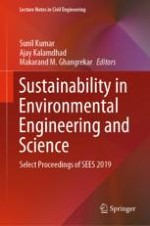This book consists of select peer-reviewed papers from the International Conference on Sustainable Environmental Engineering and Science (SEES) 2019. The main focus of the book is to propose sustainable technologies to address the growing environmental challenges. The contents cover several topics of relevance such as air pollution, solid waste management, wastewater treatment, industrial pollution, and suggests eco-friendly and cost-effective techniques to tackle them. Given the range of topics covered, the book will be useful to researchers and professionals working in the multidisciplinary area of sustainability.
